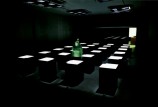24! (FACTORIAL TWENTY-FOUR)
Installation, 24 Sockel,
24 Lautsprecher, 3 PCs,
4 Videoprojektoren, 4 Spiegel/
24 pedestals, 24 speakers,
3 PCs, 4 video projectors, 4 mirrors
Sound und Programmierung/Sound and programming: Michael Aschauer
O.K und ars electronica, Linz, A, 2003; „DIGITAL TRANSIT“, Medialab Madrid, ES , Madrid, Es, 2006
de
24! ist eine räumlich-akustische-visuelle Komposition. 24 Sockel sind rasterförmig angeordnet. In jedem der Sockel befindet sich ein Lautsprecher. Auf der Oberfläche der Sockel sind Animationen zu sehen wobei ein schwarzer Pixel die quadratische Sockeloberfläche abfährt. Die Installation beruht auf einem kombinatorischem System welches wiederum auf dem binären Code basiert. Es würde 10 x 6 hoch 24 Jahre dauern um alle möglichen Variationen abzuspielen. Für einen nahezu hermetisch abgeschlossene Black Box des O.K Linz konzipiert verschachtelt 24! unterschiedliche Wahrnehmungsebenen. Die Installation versteht sich als “Minimal Media Art”. Der Sockel, als Zitat einer klassischen Präsentationsform im Kunstkontext wird als räumliches Element isoliert und seriell gruppiert. Auf die Oberfläche jedes dieser 24 Podeste trifft jeweils eine Projektion, immaterielle Lichtbilder treten an die Stelle, die üblicherweise als Basis für Objekte dient.Jede Animation ist in sich geschlossen. Das schwarze Quadrat auf weißem Grund scannt die Flächenachsen der quadratischen Sockelbasis horizontal, vertikal und diagonale ab. 24 Lautsprecher, die eine endliche Anzahl sich nicht wiederholender Kombinationen abspielen befinden sich im Inneren der Sockel. Die Tonebene ist zur Gänze digital generiert und eine exakte Übersetzung der Bildebene.
Der binäre Code liegt jedem digitalen Computersystem zugrunde. Daten an sich sind neutral, erst ihre Aktualisierung erfordert die Interpretation durch Programme; d.h. die gespeicherte Information muß in ein für den Menschen wahrnehmbares Ereignis überstetzt werden. So lassen sich z.B. aus ein und derselben Datenmenge sowohl optische als auch akustische Ergebnisse generieren. In der Installation 24! wird dieses Phänomen systematisch und kategorisch bearbeitet. Dabei wurde der kleinste gemeinsame Nenner gesucht und auf dekorative Elemente verzichtet, so dass die zugrunde liegende Struktur identisch ist mit dem endgültigen Werk. Die Installation präsentiert sich in Form ihres eigenen Skeletts.
en
Binary code is the basis of every digital computer system. Data is in and of itself neutral; it is the process of updating data that requires interpretation by programs, i.e. the sorted information must be translated into an event that human beings can perceive. Thus, for example, both optical and acoustic results can be generated from the same data. 24! is a systematic and categorical treatment of this phenomenon. In it, a simple binary code is translated into spatial, acoustic and optical reference systems. For this purpose we sought common denominators and dispensed with decorative elements so that the fundamental structure is identical with the final work. The installation presents itself in the form of its own skeleton.The work is based on the bit system and translates the four possible states that two bits can represent (00, 01, 10, 11) into the Cartesian system of coordinates. The result is the definition of four distinct points whose relative positions describe a rectangle (which, in turn, corresponds to the shape of a pixel, the smallest visual entity of the computer system). The establishment of six axes of movement lays down a finite number of possible positions relative to the four defining points, thus yielding 24 different sequences of movements within the specified geometric system. Every possible pattern of movement is combined with respect to one another, which yields a finite number of 24! (factorial twenty-four) different permutations. Once a block of 24 permutations has been gone through, the layout of the pixels is rearranged. Just as in a song´s refrain, all visible pixels move in unison, then regroup and begin with the next set of variations. The animation is played at six different speeds, corresponding to the number of vectors.
The installation is a form of „minimal media art.“ The pedestal, a classic form of presentation in the art context, is isolated as a spatial element, and 24 are arranged in a series. The small sculpture or art object one might otherwise expect to find on it is projected onto the surface of each of the 24 pedestals. Immateriality replaces materiality. Tilting the image surface is turned into a form of presentation. Each animation is self-contained; a black square on a white background moves along the axes of the pedestal´s top, thus describing the surface.
